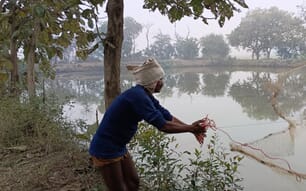Costs of energy, especially crude oil, have skyrocketed causing dramatic cost increases for intensive, commercial channel catfish farming. High energy prices have led to increased costs for distribution (processed fish and feed), electric aeration and on-farm practices relying on fossil fuels.
High crude oil prices caused a shift in corn and soybean production from foodstuffs to biofuels. Channel catfish feeds are formulated with roughly 50 per cent soybean and 30 per cent corn. The costs of feeds and feeding for catfish farming have soared. Fuel prices have not yet matched their previous highs. But because global population growth and fossil fuel consumption have increased exponentially over the past 40 years, and continue to do so, energy costs will likely reach new highs in the near future.
Grain prices, dwindling global energy supplies, and intensive production practices place the future of commercial channel catfish farming in jeopardy. Furthermore, the high feed and waste loads associated with intensive catfish farming significantly impact water quality in production ponds.
Environmental carrying capacity is determined by fish biomass and feed input. High demands are placed on environmental carrying capacity by intensive channel catfish production, creating dependence on external feed, energy and chemical inputs. Intensive farming commonly involves high stocking densities (5,000 fish/acre or greater) and high daily feed inputs (100-150 lb feed/acre). Daily aeration is needed.
To maintain maximum production, small juveniles are periodically stocked with larger catfish (“under-stocking”) – multiple batch production. The combined fish population is fed with floating feeds that target larger fish. Survival of under-stocked juveniles is often poor. It is likely that under-stocked juveniles do not compete effectively with larger fish for bigger, floating feed pellets.
Catfish farming is typically practiced intensively on large scales. Most people contacting Kentucky extension specialists about aquaculture want a production system that can be practiced on small acreage farms with minimal costs.
Production costs can be significantly decreased by reducing basic inputs and farming on a smaller scale. Low-input aquaculture allows producers to maintain much higher water quality relative to intensive production practices. Small-scale, low-input catfish farming practices offer an attractive opportunity for improving the sustainability of aquaculture in the United States.
In theory, yields of up to 3,000 lb of catfish/acre annually, without routine aeration, are possible with a total annual stocking of 2,500 cat fish/acre and a maximum daily feeding rateof 30 lb/acre.
Growth adjusted feeding for fingerlings with sinking feed for several weeks after stocking could significantly improve growth and survival of juveniles in a mixed size-class catfish population. Feeding rates, fish biomass and waste nutrient concentrations are maintained at or below pond (environmental) carrying capacity with periodic size selective harvests; preserving environmental quality.
This system could be implemented by producers with small farms but is scalable and could be adapted for moderate to large acreage production. Reduced energy and waste inputs promote long- term sustainability.
Sustainable Small-Scale Catfish Farming
William Wurts from Kentucky State University looks at sustainable small-scale catfish farming.


